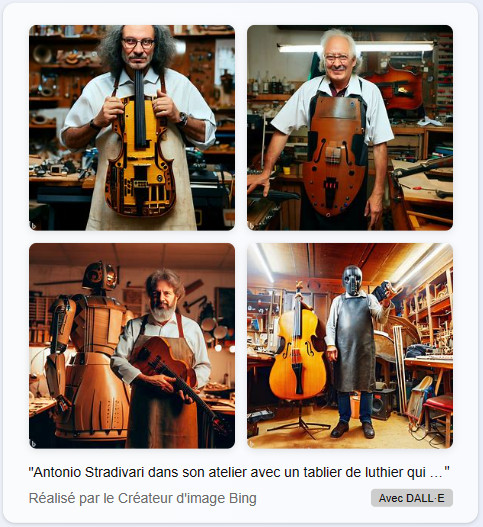As many of you know in 2023, AI has exploded, changing the way we see the world and how we work. I’ve played around with it in the interest of saving myself from repetitive office tasks. But as one who enjoys the click-clack of a keyboard, I never wanted to use OpenAI for writing. That said, I have come across some articles that made me want to give it a go. Here are the results of my experiments with AI, revealing the secrets of ChatGPT Stradivari.

Cyborg luthiers: part violin, part human…my worst nightmare!
The Secrets of ChatGPT Stradivari
I do apologize for the title of this article, which does indeed refer to Antonio Stradivari.
The AI-powered ChatGPT is (as many of you are aware) well known for its ability to generate various written works. And if you understand how to use the controls, you can do some extraordinary things with it. That being said, it’s best not to take this technology too literally, as it still doesn’t have the ability to analyze the text and its significance in the real world.
At any rate, let’s see how it does when we ask it to do the following: “Pretend that you’re Antonio Stradivari and explain what the secret to lutherie is so that a modern-day luthier can also become a part of the legacy.” Side note: I asked him the same question in English first before asking the same question in French.
Let’s see what he has to say.
What the master wants us to know
Greetings, luthier in training. My name is Antonio Stradivari, famous for my savoir-faire in the making of the greatest violins the world has ever seen. It’s an honor to reveal the secrets that have made my instruments so legendary. (I find this first paragraph over the top, but I digress…)
To begin, you must understand that the art of violin making requires unwavering devotion and a desire for perfection. Patience and attention to detail are virtues that must be developed. Now, allow me to share more detailed information on my methods.
Selection of materials
Selecting materials is crucial. Look for the best aged woods, spruce in particular for the body and maple for the back, sides and neck. Choose wood that has been dried for several years to ensure optimum stability and resonance.
Table thickness
The thickness and the shape of the instrument body greatly influences its tone quality. It’s crucial to find a balance between the body’s thickness and density. Experiment, refine, and trust your intuition to find that ideal combination that provides a rich, resonant sound.
Shape and proportions
The shape of the body and the back of the instrument is critical, as it will influence both the tone quality and its structural soundness. Analyze the shapes and curves of the classical Italian masters and study the mathematical ratios they used. Find harmony in the curves and proportions to achieve an instrument that is both aesthetically pleasing and acoustically balanced.
Varnish
Varnish protects the wood, but it also improves the overall beauty and sound quality of the instrument. Experiment with various application techniques. The focus should be on obtaining an aesthetically pleasing, lasting finish that will allow the wood to breathe and to resonate freely.
Adjustments and settings
Give a great deal of attention to the assembly of the instrument. Every step, from the positioning of the bridge to the height of the tailpiece, can deeply impact the instrument’s ease of play and sound production. Mastering the art of violin core and bridge adjustments will help ensure the instrument is responsive in its tonality and touch.
Continued learning and experimentation
Never stop learning and refining your skills. Study the works of the renowned luthiers that came before you, both from the classic Italian period to modern master craftsmen. Attend workshops, collaborate with other artisans and don’t be afraid to try out new techniques and new materials. The path to improvement is never-ending.
May you find inspiration in these words, and may your path as a luthier lead you to greatness.
What are the Chat GPT Stradivari’s secrets?
The above text is a first draft that I didn’t modify at all. So even if the ChatGPT doesn’t go into much detail, it is at the very least on the right track.
Indeed, even if there are few approximations that I won’t go into in detail about, the overall speech makes a lot of sense (the ending in particular). In fact, Mr. Stradimachine would have made an excellent CPF siphoning consultant.
Alright, so even if this article didn’t teach you anything about lutherie, I hope that at least you found it amusing. There are still many other articles on the website to discover.
